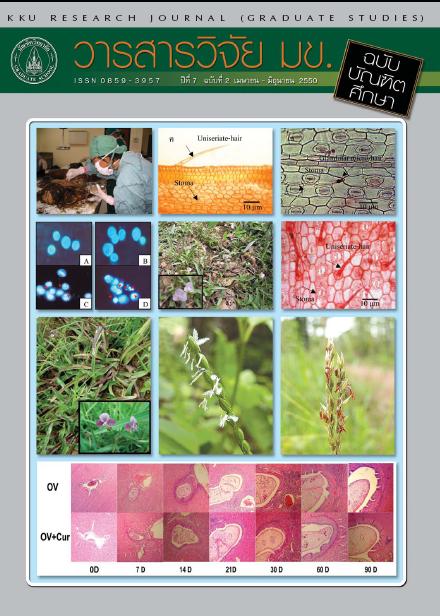A Development of Scholastic Aptitude Tests by Computerized Testing for Matthayomsuksa 6 Students(การพัฒนาแบบทดสอบวัดความถนัดทางการเรียน ที่ดำเนินการสอบด้วยคอมพิวเตอร์ สำหรับนักเรียนชั้นมัธยมศึกษาปีที่ 6)
Keywords:
Scholastic aptitude tests(แบบทดสอบวัดความถนัดทางการเรียน), Computerized testing(ดำเนินการสอบด้วยคอมพิวเตอร์)Abstract
โลกยุคปัจจุบัน เทคโนโลยีสารสนเทศได้เข้ามามีบทบาทและพัฒนาไปอย่างรวดเร็ว ดังนั้นทางด้านการศึกษาต้องรู้เท่าทันการเปลี่ยนแปลงความเจริญก้าวหน้าทางวิทยาการ โดยเฉพาะอย่างยิ่งการสร้างแบบทดสอบได้มีพัฒนาการสร้างบนคอมพิวเตอร์กันมากขึ้น เพราะคอมพิวเตอร์สามารถนำเสนอวิธีการทดสอบที่รวมเอาภาพกราฟิกและเนื้อหาสาระเข้าด้วยกัน ซึ่งให้ความแม่นยำ ถูกต้องรวดเร็ว มีประสิทธิภาพ ตลอดจนแสดงการประมวลผลคะแนนการสอบทันทีเมื่อสิ้นสุดการทดสอบ ทำให้ประหยัดทั้งเวลาและแรงงาน ดังนั้นการวิจัยครั้งนี้จึงมีความมุ่งหมาย เพื่อพัฒนาแบบทดสอบวัดความถนัดทางการเรียน ที่ดำเนินการสอบด้วยคอมพิวเตอร์ สำหรับนักเรียนชั้นมัธยมศึกษาปีที่ 6 โดยสร้างแบบทดสอบจำนวน 3 ฉบับ แต่ละฉบับมีข้อสอบจำนวน 50 ข้อ ประกอบด้วย แบบทดสอบวัดความถนัดทางการเรียนฉบับด้านภาษา ด้านตัวเลข และด้านเหตุผล กลุ่มตัวอย่างเป็นนักเรียนชั้นมัธยมศึกษาปีที่ 6 ในสังกัดสำนักงานเขตพื้นที่การศึกษาร้อยเอ็ด เขต 1, เขต 2 และเขต 3 ของปีการศึกษา 2548 จำนวน 1,375 คน ได้มาโดยการสุ่มแบบหลายขั้นตอน (Multi - Stage Random Sampling) ทำการทดสอบการใช้เครื่องมือในการวิจัยจำนวน 3 ครั้ง การตรวจสอบหาคุณภาพของแบบทดสอบครั้งที่ 3 ดำเนินการสอบด้วยคอมพิวเตอร์ โดยการหาค่าความเที่ยงตรง ค่าความยาก ค่าอำนาจจำแนก ค่าความเชื่อมั่น และการสร้างเกณฑ์ปกติของแบบทดสอบที่สร้างขึ้น ผลการวิจัยปรากฏดังนี้ 1. การหาคุณภาพของแบบทดสอบ 1.1 ความเที่ยงตรงเชิงเนื้อหา โดยผ่านผู้เชี่ยวชาญจำนวน 5 คน ได้ค่าดัชนีความสอดคล้อง (IOC) ของแบบทดสอบที่สร้างขึ้นตั้งแต่ 0.60 – 1.00 ทุกฉบับ 1.2 ความเที่ยงตรงเชิงโครงสร้าง โดยใช้เทคนิคกลุ่มรู้ชัด (Known – Group Technique) โดยเปรียบเทียบผลคะแนนเฉลี่ยจากแบบทดสอบวัดความถนัดทางการเรียนของกลุ่มสูง และกลุ่มต่ำของแต่ละฉบับมาทดสอบความแตกต่าง ซึ่งแต่ละฉบับกลุ่มสูงมีผลคะแนนเฉลี่ยความถนัดทางการเรียนสูงกว่ากลุ่มต่ำมีความแตกต่างกันอย่างมีนัยสำคัญทางสถิติที่ระดับ .01 1.3 ความเที่ยงตรงเชิงพยากรณ์ โดยการหาค่าสัมประสิทธิ์สหสัมพันธ์แบบเพียร์สัน ระหว่างผล การเรียนเฉลี่ย (GPA) กับผลคะแนนจากแบบทดสอบวัดความถนัดทางการเรียนด้านภาษา ด้านตัวเลข และด้านเหตุผลเท่ากับ .77, .75 และ .79 ตามลำดับ ซึ่งมีความสัมพันธ์กันอย่างมีนัยสำคัญทางสถิติที่ระดับ .01 1.4 ค่าความยากของข้อสอบด้านภาษา ด้านตัวเลข และด้านเหตุผล ตั้งแต่ .29 ถึง .72, .25 ถึง .78 และ .26 ถึง .77 ตามลำดับ ค่าอำนาจจำแนกตั้งแต่ .21 ถึง .78, .22 ถึง .98 และ .23 ถึง .94 ตามลำดับ และค่าความเชื่อมั่นของแบบทดสอบ โดยใช้สูตร KR–20 ของ Kuder – Richardson แบบทดสอบด้านภาษา ด้านตัวเลข และด้านเหตุผลเท่ากับ .86, .89 และ .93 ตามลำดับ 2. การสร้างเกณฑ์ปกติ (Norms) ของแบบทดสอบวัดความถนัดทางการเรียนด้านภาษา ด้านตัวเลข และด้านเหตุผลได้คะแนนทีปกติตั้งแต่ 4 ถึง 81, 18 ถึง 76 และ 15 ถึง 74 ตามลำดับ โดยสรุป แบบทดสอบที่ผู้วิจัยสร้างขึ้นทุกฉบับ มีคุณภาพเข้าเกณฑ์มาตรฐาน ซึ่งมีความเหมาะสมที่จะนำไปใช้ในการวัดความถนัดทางการเรียน ที่ดำเนินการสอบด้วยคอมพิวเตอร์ สำหรับนักเรียนชั้นมัธยมศึกษาปีที่ 6 เพื่อใช้ในการพยากรณ์ความสามารถของบุคคลในอนาคต และนำผลการสอบมาพัฒนาปรับปรุงการเรียนการสอนและการแนะแนวให้ดียิ่งขึ้นต่อไป
A present an information technology has played a prominent role and is fast developed. The field of education must be well equipped to catch up with the change and advancement of technology. Particularly, tests are more and more being developed on computer because computerized testing provides both graphics and contents altogether in a test. It is accurate, fast and effective. Besides, a test result can be revealed in a few minutes after the test. Thus, time and energy are saved. The purpose of this study was to develop scholastic aptitude tests on computer for Matthayomsuksa 6 students. The researcher developed a test which was comprised of three subtests : verbal aptitude test, numerical aptitude test and reasoning aptitude test. Each subtest contained 50 items. The sample group was comprised of 1,375 Matthayomsuksa 6 students in Roi-et Education Areas 1, 2 and 3 in educational year 2005. They were selected by a multi - stage random sampling technique. The study tool was tested three times. The third testing was administered by computerized testing the values of validity, difficulty, discrimination, reliability and to set norms of the tests developed. The results were as the following : 1. Examining the Quality of the Tests 1.1 The content validity was examined by five experts to identify Index of Consistency (IOC) of the tests developed which ranged from 0.60 - 1.00 for every test. 1.2 The construct validity was evaluated by a Known - Group Technique by comparing means of the high - scored and low scored groups of each sub - test to find the difference and it was revealed that the difference was statistically significant at .01. 1.3 A predictive validity between GPA and results of verbal, numerical and reasoning (SAT) aptitude tests were .77, .75 and .79 respectively. The correlation between GPA and SAT was statistically significant at .01. 1.4 The values of difficulties of verbal, numerical and reasoning aptitude tests were .29 -.72, .25 - .78 and .26 - .77 respectively; and their discrimination powers were .21 - .78, .22 - .98 and .23 - .94 respectively and the values of a reliability, as calculated by the KR-20 of verbal, numerical and reasoning aptitude tests were .86, .89 and .93 respectively. 2. Normalized T - Score of the test norms of verbal, numerical and reasoning aptitude tests were 4 - 81, 18 - 76 and 15 - 74 respectively. In conclusion, the developed scholastic aptitude tests are standardized and appropriate to be administered to Matthayomsuksa 6 students to predict each individual studentís ability and to improve teaching and learning approaches and guidance



